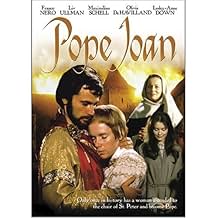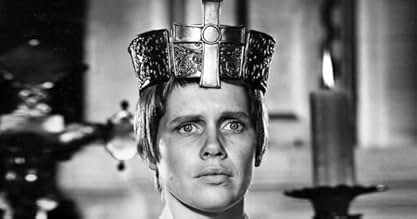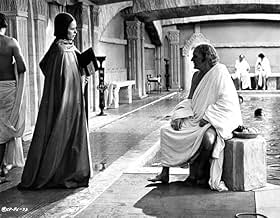Ajouter une intrigue dans votre langueIn medieval Europe, a pious young woman becomes a scholar of theology, disguises herself as a man, rises through the Catholic Church hierarchy and is elected Pope.In medieval Europe, a pious young woman becomes a scholar of theology, disguises herself as a man, rises through the Catholic Church hierarchy and is elected Pope.In medieval Europe, a pious young woman becomes a scholar of theology, disguises herself as a man, rises through the Catholic Church hierarchy and is elected Pope.
Commentaire à la une
The early 1970's was my favourite period in recent cinema history, classics such as Kubrick's Clockwork Orange, Skolimowsky's Deep End and Visconti's Death in Venice abound; but there are some, less than ringing endorsements of the era, this half-forgotten movie being one.
Liv Ullman, the embodiment of Scandinavian sang-froid, the epitome of ephemeral solemnity, plays Joan, a pious and youthful nun, who travels from a medieval convent, burnt down by Saxons, raping and pillaging, as if they misconstrued it for a set on a Ken Russell film, to Rome where disguised as a (rather attractive) young man, she wins her spurs, becomes a cardinal and eventually the first - and possibly last - female pope.
The trouble is, although Liv's performance is full of meaning and her fights against the alleged sin of lust, particularly enthralling, the editing, jumpiness and preposterousness of some scenes, leave an anxious viewer in need of redemption elsewhere.
True, it is interesting to see actors of the time - Lesley Anne Down, Maximillian Schell, Trevor Howard and Olivia de Havilland - giving robust performances, but a sandwich with an attractive filling is hardly worth eating if the bread is stale. And this is a stale mish mash, which ultimately fails to satisfy. It is a shame. The theme is interesting, whether the story is true or not. Given the current arguments amongst many religions on the role of women, it has significance for us in the 21st Century.
The scenery around Brasov, Romania, where it was filmed, which I visited post Ceausescu, is exemplary. Mind you, maybe the reason for the film's disjointed nature is just that - that the dictator, in his first flush of dictatorial youth, was in charge of production. There again, maybe Ceausescu was a woman. Now that would be a tale worth telling...
Liv Ullman, the embodiment of Scandinavian sang-froid, the epitome of ephemeral solemnity, plays Joan, a pious and youthful nun, who travels from a medieval convent, burnt down by Saxons, raping and pillaging, as if they misconstrued it for a set on a Ken Russell film, to Rome where disguised as a (rather attractive) young man, she wins her spurs, becomes a cardinal and eventually the first - and possibly last - female pope.
The trouble is, although Liv's performance is full of meaning and her fights against the alleged sin of lust, particularly enthralling, the editing, jumpiness and preposterousness of some scenes, leave an anxious viewer in need of redemption elsewhere.
True, it is interesting to see actors of the time - Lesley Anne Down, Maximillian Schell, Trevor Howard and Olivia de Havilland - giving robust performances, but a sandwich with an attractive filling is hardly worth eating if the bread is stale. And this is a stale mish mash, which ultimately fails to satisfy. It is a shame. The theme is interesting, whether the story is true or not. Given the current arguments amongst many religions on the role of women, it has significance for us in the 21st Century.
The scenery around Brasov, Romania, where it was filmed, which I visited post Ceausescu, is exemplary. Mind you, maybe the reason for the film's disjointed nature is just that - that the dictator, in his first flush of dictatorial youth, was in charge of production. There again, maybe Ceausescu was a woman. Now that would be a tale worth telling...
- michael-1151
- 13 janv. 2008
- Permalien
Histoire
Le saviez-vous
- AnecdotesAfter a muted critical response, the film was severely re-edited. In its original incarnation, the film contained many flashbacks and flash-forwards, quite a progressive style for 1972. These were all removed to create a more linear story and the film was then released as "The Devil's Imposter". These changes were reinstated for a 2009 reissue.
- Versions alternativesIn the version shown on BBC TV on 22nd October 2005, the 20th-century bookend scenes are cut, Keir Dullea and Robert Beatty do not appear, and the film ends abruptly with the crowd descending on Joan.
- ConnexionsFeatured in A Quiet Revolution (1972)
Meilleurs choix
Connectez-vous pour évaluer et suivre la liste de favoris afin de recevoir des recommandations personnalisées
- How long is Pope Joan?Alimenté par Alexa
Détails
- Date de sortie
- Pays d’origine
- Langue
- Aussi connu sous le nom de
- The Devil's Imposter
- Lieux de tournage
- Brasov, Roumanie(mountain top castle scenes)
- Sociétés de production
- Voir plus de crédits d'entreprise sur IMDbPro
- Durée2 heures 12 minutes
- Mixage
- Rapport de forme
- 2.35 : 1
Contribuer à cette page
Suggérer une modification ou ajouter du contenu manquant

Lacune principale
By what name was Jeanne, papesse du diable (1972) officially released in India in English?
Répondre




























